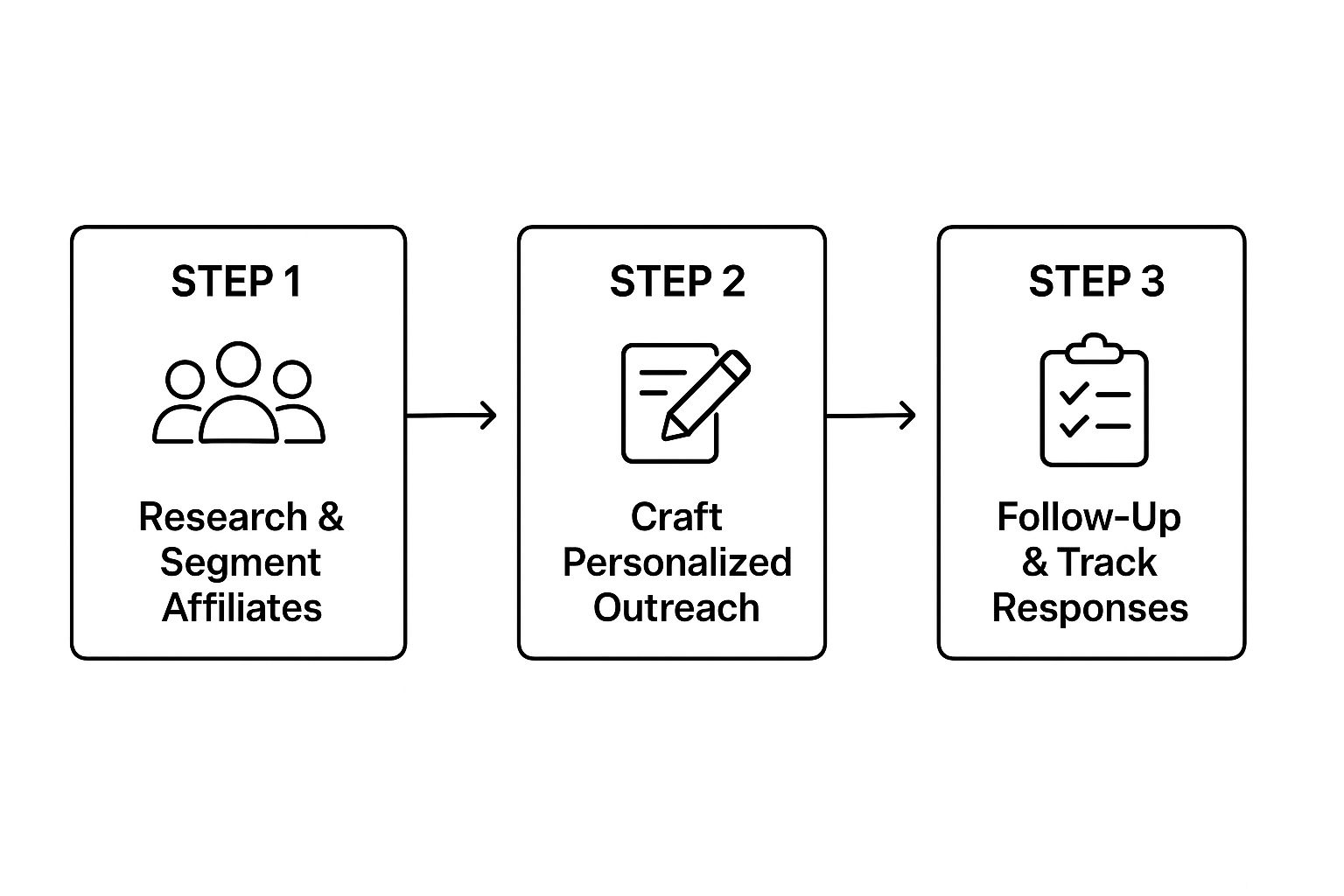Let's be honest: before you can even think about finding affiliates, you have to build a program they're genuinely excited to join.
Build a Program That Top Affiliates Want to Join
You can't just throw a commission rate out there and hope for the best. Top-tier affiliates—the ones who can actually move the needle for your business—are selective. They get pitched constantly, and they've developed a keen sense for spotting a half-baked program from a mile away.
Your first move is to get crystal clear on who your ideal partner is. Go beyond simple demographics. Who are the specific creators, niche bloggers, or industry voices that your target customers already listen to and trust? Think about whose content and audience perfectly mirror your brand's values.
Craft a Competitive Offer
Naturally, your commission structure is a huge part of the appeal. It needs to be attractive enough to catch the eye of high-quality partners but also sustainable for your own business model. A good starting point is to see what your direct competitors are offering, but don't get trapped in a race to the bottom by simply matching them.
A higher commission percentage might look good on paper, but savvy affiliates know that a strong brand with high conversion rates and stellar partner support is often far more valuable than an extra percentage point.
Think about which model makes the most sense for you:
- Percentage of Sale: This is the classic model, offering a set percentage for every sale. It's straightforward and easy to understand.
- Flat Fee Per Sale: Great for single-price products or services, this model offers a fixed dollar amount for each conversion.
- Tiered Commissions: This is a fantastic way to motivate your best partners by rewarding them with higher commission rates as they hit specific sales milestones.
Prepare Your Essential Assets
Once you’ve settled on the numbers, it's time to get your house in order. You need to have all your essential assets ready before a single outreach email goes out. Nothing screams "amateur hour" to an experienced affiliate like a disorganized, clunky launch.
This means having a dedicated, compelling landing page that clearly spells out the benefits of your program, along with a simple, easy-to-follow onboarding kit. For a much deeper look into setting all this up, our complete guide on affiliate program management walks you through every detail.
Getting this foundation right is more important than ever. The affiliate market is booming—it now drives 16% of all internet orders in the US and is on track to become a $27.78 billion industry by 2027. If you want to grab a piece of that pie, you need a program built for success from day one. You can dig into more of these trends by reviewing the latest affiliate marketing statistics.
Uncovering High-Potential Affiliates in Your Niche

Now that you've built a solid program framework, it’s time to shift from planning to prospecting. The real secret to finding great affiliates isn't about casting the widest net possible. It's about using a high-powered lens to spot the right partners.
A generic Google search will only get you so far. A much smarter move? Reverse-engineer your competitors' success. Just think about it: who is already out there, successfully promoting products almost identical to yours? These are the people with a proven track record and, more importantly, an audience that’s already warmed up to what you offer.
Digging into Competitor Backlinks
One of the most direct ways to find these affiliates is by digging into your competitors' backlink profiles. With an SEO tool like Ahrefs or Semrush, you can instantly pull up a list of nearly every website linking to your rivals. A significant chunk of these links will be from affiliates—bloggers, review sites, and content creators who have already written about similar products.
As you sift through this data, filter the list to focus on high-quality content sites. I like to look for URLs that contain keywords like "review," "best," "comparison," or "alternative." This little trick helps you quickly zero in on the exact articles and creators who are driving real traffic and sales for your competition.
The goal isn't just to find any link; it's to find partners with genuine authority. An endorsement from a trusted niche blogger is often more valuable than a dozen links from low-quality deal sites.
By creating a list of these proven affiliates, you’re not starting from square one. You're building a highly qualified prospect list of partners who are already active and successful in your specific market. This is a game-changer.
Tapping into Niche Communities and Social Channels
Beyond looking at direct competitors, your next best source for affiliates is where your ideal customers hang out online. These are the hidden gems that bigger brands often overlook completely.
Niche Forums and Subreddits: Spend some time in relevant forums and subreddits. If you sell project management software, for example, communities like the r/projectmanagement subreddit are goldmines. They are filled with power users and micro-influencers who could become incredible partners.
Facebook and LinkedIn Groups: Join groups dedicated to your industry. Don't just lurk—observe. See who is consistently answering questions, sharing real expertise, and earning the trust of the community. These are the people whose recommendations carry weight.
Social Media Hashtags: Run searches for relevant hashtags on Instagram, TikTok, and even Twitter. This is a fantastic way to uncover creators who are genuinely passionate about your niche. Pay special attention to those who show they have a knack for mastering social media content strategy, because their ability to engage an audience is a massive indicator of their potential as an affiliate.
Taking this multi-channel approach helps you build a diverse and resilient pipeline of potential partners. You're not just finding people with a website; you're finding influential voices who have already built the trust and engagement you need.
Using Affiliate Networks and Platforms to Scale Your Search

While manually hunting for partners is a fantastic way to start, it's tough to scale. Sooner or later, you'll need a more efficient way to grow. This is where affiliate networks and discovery platforms come in—they're like a supercharger for your recruitment efforts, putting you in touch with thousands of potential partners who are actively looking for programs just like yours.
Think of these platforms as dedicated marketplaces. Big names like ShareASale, CJ Affiliate, and Rakuten Advertising host enormous, diverse pools of affiliates, from tiny niche bloggers to massive media companies. The real beauty here is efficiency. These networks take care of the heavy lifting—like tracking, reporting, and payments—so you can pour your energy into what really matters: building strong relationships.
Navigating the Affiliate Marketplace
Just signing up for a network won’t get you very far. You have to know how to work the system. Most platforms offer a searchable database of their partners, and the magic is in the filters. Use them to zero in on affiliates who match your brand's DNA.
Here’s what I typically look for:
- Category or Niche: The most important filter. You need partners who operate in your specific vertical to ensure their audience will actually care about what you sell.
- Promotional Methods: Are you looking for content creators, YouTubers, coupon sites, or social media influencers? Filter for the promotional channels that fit your brand best.
- Performance Metrics: Many networks display affiliate performance data, like their network earnings or average click-through rates. I always prioritize partners with a proven track record of driving results.
A targeted approach like this transforms your search from aimless browsing into a strategic hunt for high-potential recruits. It ensures you find people who are a natural fit for the specific affiliate marketing strategies you're deploying.
The real power of these networks lies in their discovery tools. Instead of cold outreach, you're connecting with partners who have already raised their hand and shown interest in affiliate marketing.
Specialized platforms can give you an even bigger head start. Take the Refgrow Referral Exchange, for instance. It’s built specifically to connect new programs with a network of active SaaS affiliates instantly. This cuts out a ton of the initial friction and gets you matched with partners who already get your business model, creating a growth loop right from day one.
The sheer amount of money pouring into this channel tells you everything you need to know. Affiliate marketing spend in the U.S. alone is expected to hit nearly $12 billion in 2025, which is a huge leap from $9.56 billion in 2023. This explosive growth underscores just how vital these partnerships have become. By using these networks and platforms, you’re plugging into a thriving ecosystem built for one thing: scale.
Crafting Outreach That Actually Gets a Response
You’ve got your list of dream affiliates. Now comes the hard part: getting them to actually open, read, and reply to your message. The inbox of a great affiliate is a battlefield, flooded with generic, copy-paste requests. If you want to stand out, your pitch needs to feel like it was written by a human, for a human.
The biggest mistake I see brands make? They make the outreach all about themselves. An email that opens with "We're looking for affiliates for our awesome product" is doomed from the start. You have to flip the script and make it about them.
Personalize Beyond Just a First Name
Mail merge isn't personalization. True personalization shows you've actually engaged with their work. It proves you’re not just another spammer hitting "send all."
Before you even type a word, spend five minutes on their site or channel. Find something specific. Did they write a killer blog post? Film a helpful YouTube tutorial? Share a unique take on social media? Mention it.
Here’s an example of an opener that works:
"I just finished your recent article comparing project management tools, and I especially appreciated your breakdown of Gantt chart features—it’s something most reviewers gloss over."
An opening like this instantly builds rapport. It tells the creator you value their expertise, not just their follower count. It’s a sign of respect, and it’s your ticket to getting them to read the next sentence.
A successful outreach campaign isn't just a single email; it's a structured process. You have to move from research to personalization and then follow-up with a clear plan.

As you can see, personalization is the thread that connects every stage of a successful recruitment strategy.
What’s the Best Way to Reach Out?
Email is the go-to for many, but it's not the only game in town. Depending on the affiliate, a DM on social media or a LinkedIn message might get a faster response. Each channel has its own quirks and best practices.
Here’s a quick comparison to help you decide where to focus your efforts.
Effective Outreach Channel Comparison
| Channel | Pros | Cons | Best For |
|---|---|---|---|
| Professional, allows for detailed pitches, easy to track. | Highly crowded, low open rates if not personalized. | Formal partnership proposals, reaching established bloggers and content creators. | |
| Social Media DMs | Direct, personal, can feel more conversational. | Can be seen as spammy, character limits, messages can get lost. | Quick, informal outreach to influencers you already follow and engage with. |
| Professional context, easy to see their professional background. | InMail can feel corporate, not all creators are active. | Reaching B2B influencers, industry experts, and thought leaders. |
Ultimately, the best channel is the one your ideal affiliate uses most. A bit of research here goes a long way.
Clearly Show Them What’s In It For Them
Once you've broken the ice, get straight to the point. Why should they partner with you? Don't just throw your commission rate at them. Connect the dots and show how this partnership benefits their audience and their brand.
- Solve Their Audience's Problem: Briefly explain why your product is the perfect fit for the people who trust them.
- Showcase the Perks: Lead with your competitive commission rate but also mention other benefits. Do you offer a 90-day cookie duration? A dedicated manager? Free products for testing?
- Make it Scannable: Use bullet points and bold text. No one has time to decipher a wall of text on their phone.
To really nail the delivery and avoid common pitfalls, it’s worth brushing up on email prospecting best practices. Little tweaks can make a massive difference in your response rates.
Make Saying "Yes" Easy
End your message with a simple, low-friction call to action. Vague requests like "Let me know what you think" create work for them. Make the next step incredibly easy.
Try something like: "Does a quick 15-minute chat next week sound good?" or "You can see all the program details and sign up in two minutes right here."
Don't forget to follow up! People are busy, and inboxes are chaotic. A single email can easily be missed. A polite, brief follow-up message 3-5 days later can easily double your response rate. Persistence, when done respectfully, pays off.
Recruiting Influencers as Powerful Affiliate Partners
The old walls separating traditional affiliates from social media influencers have completely crumbled. What we’re left with is a huge opportunity to build performance partnerships rooted in real trust and authenticity.
Bringing YouTubers, TikTok creators, and top-tier bloggers into your affiliate program isn’t just about getting another link out there. It’s about plugging into a pre-existing relationship—one between a creator and their dedicated audience. When an influencer they follow and trust recommends a product, it lands differently. It feels like a genuine tip from a friend, not a canned advertisement. This is where modern affiliate marketing is making its biggest impact.
Identifying Creators with True Influence
First things first, you need to find creators whose audience is a dead ringer for your ideal customer. And let me be clear: this has very little to do with raw follower counts. The secret ingredient here is audience alignment.
Look for influencers whose content, personal values, and community vibe match your brand perfectly. A creator with 10,000 hyper-engaged followers in your specific niche can be worlds more valuable than someone with a million generic followers who don't care about what you sell. It’s also incredibly important to learn how to find Amazon influencers who actually drive sales, because their track record for converting is a massive green flag.
The best endorsements come from creators who would genuinely use and love your product even if you weren't paying them. That kind of authenticity is priceless—and impossible to fake. It’s what leads to better customers.
Structuring a Deal They Can't Refuse
Once you have your shortlist of potential partners, how you approach them is everything. Your pitch needs to sound like a collaborative partnership, not a cold, transactional offer. Believe me, these creators get dozens of generic pitches a day, so yours has to cut through the noise. Don't just lead with a commission rate.
Think about framing the partnership in a way that feels unique to them.
Here are a few ways to structure the deal:
- Product Seeding: Start by offering your product for free with zero strings attached. This lets them experience it firsthand. If they fall in love with it, a formal affiliate partnership is the natural next step.
- Hybrid Models: Offer a blend of an upfront fee for their time and creative work, plus a backend commission on sales. This shows you respect their craft while still focusing on performance.
- Tiered Commissions: Create incentives that reward your best-performing influencers. As they hit certain sales targets, unlock higher commission rates for them.
This approach elevates a simple affiliate link into a powerful, trust-based endorsement. We’ve seen brands that merge their influencer and affiliate strategies achieve up to a 46% increase in affiliate-driven sales. The numbers don't lie.
If you want a more detailed playbook on this, be sure to check out our full guide on how to recruit affiliates.
Common Questions About Finding Affiliates

Starting to recruit affiliates always kicks up a lot of questions. If you're feeling a bit lost in the weeds, don't worry—that's completely normal. To help clear things up, I've pulled together the most common questions I hear from new affiliate managers and laid out some direct, no-fluff answers.
Think of this as your personal FAQ for getting through those tricky early stages with confidence. We’ll tackle timelines, rookie mistakes, and the big strategic decisions you'll need to make right out of the gate.
How Long Does It Realistically Take to Find Good Affiliates?
This is the million-dollar question, and I'll be straight with you: it depends, but it's never an overnight thing. Finding high-quality partners who genuinely vibe with your brand and have a real connection with their audience takes patience and consistent effort.
For most brands starting from square one, expect to spend the first 1-3 months digging into research, sending outreach, and getting your first few partners set up. In that time, you might land a handful of really solid affiliates. The goal here is quality, not quantity.
It's far better to onboard five highly-aligned, motivated affiliates than 50 low-quality partners who produce zero results. That initial phase is all about building a strong foundation, not just hitting a vanity metric.
Once you’ve put in 3-6 months of continuous work, you should start to see a steady trickle of results. By then, you'll have a much better feel for which types of partners are moving the needle for your business. This is when your program really starts to build momentum.
What Are the Biggest Mistakes to Avoid When Starting?
So many new affiliate managers trip over the same hurdles. Just knowing what they are can save you a world of time and frustration as you figure out how to find the right affiliates for your program.
From my experience, these are the top mistakes to watch out for:
- Generic, Mass Outreach: Sending a bland, copied-and-pasted email to hundreds of people is the fastest way to get your emails deleted. Personalization is everything.
- Focusing Only on Commission: A competitive commission is important, of course, but it’s not the only draw. The best partners are looking for a brand they believe in, great support from you, and a product that converts well.
- Poor Onboarding: Getting an affiliate to sign up is only half the job. If you don't give them the tools, information, and support they need to succeed from day one, that initial spark of excitement will fizzle out fast.
- Ignoring Smaller Creators: Don't let huge follower counts dazzle you. I've seen micro-influencers and niche bloggers with incredibly engaged, high-trust audiences drive absolutely phenomenal results.
Sidestepping these common errors will dramatically boost your odds of building strong, profitable, and lasting affiliate relationships. It helps you shift from a "fill the roster" mentality to building a true community of brand advocates.
Should I Use an Affiliate Network or Go In-House?
This is a major strategic fork in the road, and the right path really depends on your resources, your goals, and your industry. There are real pros and cons to both building your own program from scratch and joining an established network.
Let's break down the key differences.
In-House vs. Affiliate Network
| Aspect | In-House Program (e.g., using a tool like Refgrow) | Affiliate Network (e.g., ShareASale, CJ) |
|---|---|---|
| Control & Branding | Full control. The program is 100% yours, branded to match your site perfectly. | Less control. Your program lives inside a third-party platform with their branding. |
| Fees | Lower, predictable costs. Usually a flat monthly software fee with no extra transaction costs. | Higher costs. You're often looking at setup fees, monthly minimums, and a cut of every commission. |
| Affiliate Discovery | More targeted. You build your own prospect list or use a curated exchange. | Broader reach. Gives you access to a huge, pre-existing marketplace of affiliates. |
| Relationship | Direct. You build a personal, one-on-one relationship with every partner. | Indirect. The network acts as a go-between, which can sometimes feel impersonal. |
Ultimately, an in-house program gives you total control and is often way more cost-effective, which is why it's a popular choice for SaaS and digital product companies. On the flip side, a network like ShareASale or CJ offers immediate access to a massive pool of affiliates but costs more and gives you less say over the branding. This decision will shape how you find and manage your partners from here on out.
Ready to take full control of your partnerships? With Refgrow, you can launch a fully native, beautifully integrated affiliate program right inside your app with just one line of code. Stop paying network fees and start building direct relationships with partners who love your product. Explore Refgrow today and see how easy it is to launch and scale.

